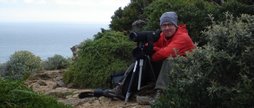15 intrepid members of Wildlife Trust staff and their friends headed for Burnham Norton on Friday 2nd February for a weekend of birding and chilling on the coast. We stayed at Burnham Deepdale Hostel.
SaturdaySaturday dawned crisp and bright, and so the merry band of Trust staff and friends headed for Holkham Park, in search of woodland birds.
 Holkham Park
Holkham ParkThis large country estate is home to a large herd of Fallow Deer, which were grazing on the grassland in front of the manor house. There was no sign of any Lesser Spotted Woodpeckers or Hawfinches, but the group did enjoy excellent views of Nuthatches feeding among some of the huge parkland trees, plus a winter plumaged Mediterranean Gull loafing on the lake. Also on the lake were small numbers of wildfowl, including Goldeneye, Shoveler, Gadwall, Pochard and Tufted Duck, whilst around the grasslands were several noisy Egyptian Geese and a couple of pairs of feral Barnacle Geese.

Black Brant, Holkham
Next, we headed for Lady Ann’s Drive and Holkham Gap. A huge flock of Pink-footed Geese were resting on the wet grasslands to the west of the road, whilst a small flock of Dark-bellied Brent Geese were on the grass to the east. Among these were one or two Black Brants, the subspecies that breeds in Arctic Canada and Russia, identifiable by their blacker overall plumage, bright white flank stripes and larger white “necklace”.
 Holkham Beach
Holkham BeachWe proceeded on to the beach where some of the group were quickly rewarded with a small flock of nine Shore Larks, sporting bright yellow faces and black bandit masks and horns, in contrast to their rather drab body plumage. Further down the beach, small numbers of Sanderling were feeding along the strandline and out to sea a large flock of Common Scoters were bobbing in the waves, along with a few Common Eider and Red-breasted Mergansers.
Chips at Wells harbour was the next stop as is the law on birding trips to this part of Norfolk. Deep fried food was enjoyed whilst watching five Little Grebes in the harbour channel and a Little Egret feeding in a tidal pool. We then headed on to Thornham where we quickly located the Lesser Yellowlegs feeding in the tidal channel. This rare North American wading bird is about the size of a Redshank, but slimmer and with longer legs, which, as it’s name suggests, are bright yellow. The bird showed well for a while before being flushed by other birders. In flight, the birds’ small white rump patch and lack of any wing bars were noted. A few hardy members of the group continued to enjoy the late afternoon sunshine, and walked along the sea wall towards Holme, where they enjoyed some excellent views of two Short-eared Owls. The lazier members of the group headed for the White Horse pub in Burnham to watch the rugby.

Lesser Yellowlegs, Thornham
Sunday
Another bright, calm day on the coast with many birds singing first thing in the morning, including Song Thrush and Robin. After a hearty breakfast, we headed for Titchwell. Here, we were treated to superb, close views of a pair of Bearded Tits feeding on phragmites heads right next to the path.

Bearded Tit, Titchwell
On the lagoons, a handful of Avocets were present, braving the winter, whilst a single Spotted Redshank lurked distantly on the brackish lagoon. A large flock of Golden Plover were roosting on the islands in the same lagoon, and they were disturbed at one point by a female Merlin, which hurtled west low over the heads of a lucky few members of the group. Nearby, a couple of Black-tailed Godwits showed well, feeding in a pool next to the path.
The group then walked to the beach where a large wreck of razorshells was discovered. Offshore were more Red-breasted Mergansers and a couple of Goldeneye, plus a huge flock of gulls attracted to a trawler. Among these, there were several Kittiwakes and a Mediterranean Gull. Along the shore were many wader species, including Bar-tailed Godwits, Dunlin, Turnstone, Oystercatcher and Curlew.
Following lunch in Thornham, we headed down to Snettisham, spotting a Barn Owl from the car as we approached the site. The Pink-footed Goose flight did not really happen as it seemed that the birds must have been feeding further to the north and therefore did not come in to roost from the expected direction. There were large numbers of birds present on the mudflats, and intrigue was created by a large bulky mass out in the Wash, which some members of the group were convinced was a dead whale! The highlight for some of the group was another Barn Owl, which showed well, hunting over some tussocky grassland near the car park. A Grey Partridge calling near the car park ended the weekend in fine style.

For further photos please see http://www.indybirder.com/
 Snow Bunting, on the beach at Snettisham
Snow Bunting, on the beach at Snettisham












